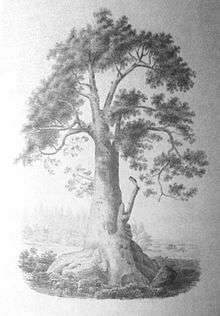Cyphostemma mappia
| Cyphostemma mappia | |
|---|---|
 | |
| Juvenile Mapou Tree in cultivation | |
| Scientific classification | |
| Kingdom: | Plantae |
| (unranked): | Angiosperms |
| (unranked): | Eudicots |
| (unranked): | Rosids |
| Order: | Vitales |
| Family: | Vitaceae |
| Genus: | Cyphostemma |
| Species: | C. mappia |
| Binomial name | |
| Cyphostemma mappia (Lam.) Galet | |
| Synonyms | |
| |
Cyphostemma mappia (Mapou tree or Bois Mapou) is a species of caudiciform succulent plant endemic to Mauritius. It is sometimes known as the Mauritian baobab.
This species is endangered, but is beginning to be propagated in its native country, as an ornamental landscaping plant.[1]
Description

It is a soft-stemmed caudiciform tree, with succulent green leaves on fragile, chunky, elastic, distinctively zig-zag branches. It can eventually reach a height of nearly 10 meters, and develop a vastly expanded, swollen, water-filled trunk. This means that it can resemble a baobab in shape.
As a case of "island gigantism", it is the only Cyphostemma species to attain the size of a large tree. It has also lost the vine-like tendrils of its genus, which falls within the greater Vitaceae (grapevine) family.
In exposed areas, it tends to be shorter and more robust - only a few meters tall. In more protected environments, it grows up to 10 meters in height. The wood is soft and fleshy, like that of a true baobab. It is therefore sometimes confused both with the Baobab (Adansonia digitata) or with the genera Calpidia or Pisonia which all have similar fleshy trunks.
Like many other endemic Mauritian plants, it has heterophyllous leaves, due to having evolved with the presence of grazing giant tortoises. The plants still exhibit this heterophylly, even though the Cylindraspis giant tortoise species of Mauritius are now extinct. Leaves of young plants are longer, thinner and lighter red-coloured - and are mostly ignored by tortoises. In older plants, where the leaves are out of reach of giant tortoises, the leaves are larger, broader and greener. The leaves are compound, with odd numbers of leaflet segments, and it is typically deciduous.
It produces flowers from January through May and sometimes they remain for as long as October. The fruits are small, red, velvety berries.[2]
Distribution
It used to be widespread throughout the dry and semi-dry forests of the island, but especially in more exposed or mountainous areas. It was reported to be extremely common especially on and around Le Pouce and the town of Mapou (to which it gave its name), although it was already rare there by 1800. It was also reported in large numbers in the hills and mountains around Moka; as well as in the lowland forests across the island.
It was exterminated from much of its natural range, but can still occasionally be found on extremely rocky slopes or outcrops in the higher mountains. It can be found on the mountain ranges of Trois Mamelles and Rempart, and in some of the remaining dry forests in the west of the island, especially around Magenta and Yemen.
It is relatively slow-growing, but is increasingly used as a decorative ornamental for hotels and public landscaping in Mauritius. It is easily propagated by seed, or by cuttings which can be rooted in a shady environment.[3][4]
Sources
- ↑ http://www.theplantlist.org/tpl/record/kew-2752803
- ↑ U.Eggli: Illustrated Handbook of Succulent Plants: Dicotyledons. Springer Science & Business Media, 2002. p.460.
- ↑ http://www.lemauricien.com/article/ecologie-bois-mapou-exemple-d%E2%80%99evolution-vers-gigantisme
- ↑ G.Rouillard: Les Plantes et Leur Histoire a L'ile Maurice. Mauritius. 1999. ISBN 9990331065 p.160.
| Wikimedia Commons has media related to Cyphostemma mappia. |
